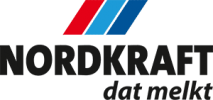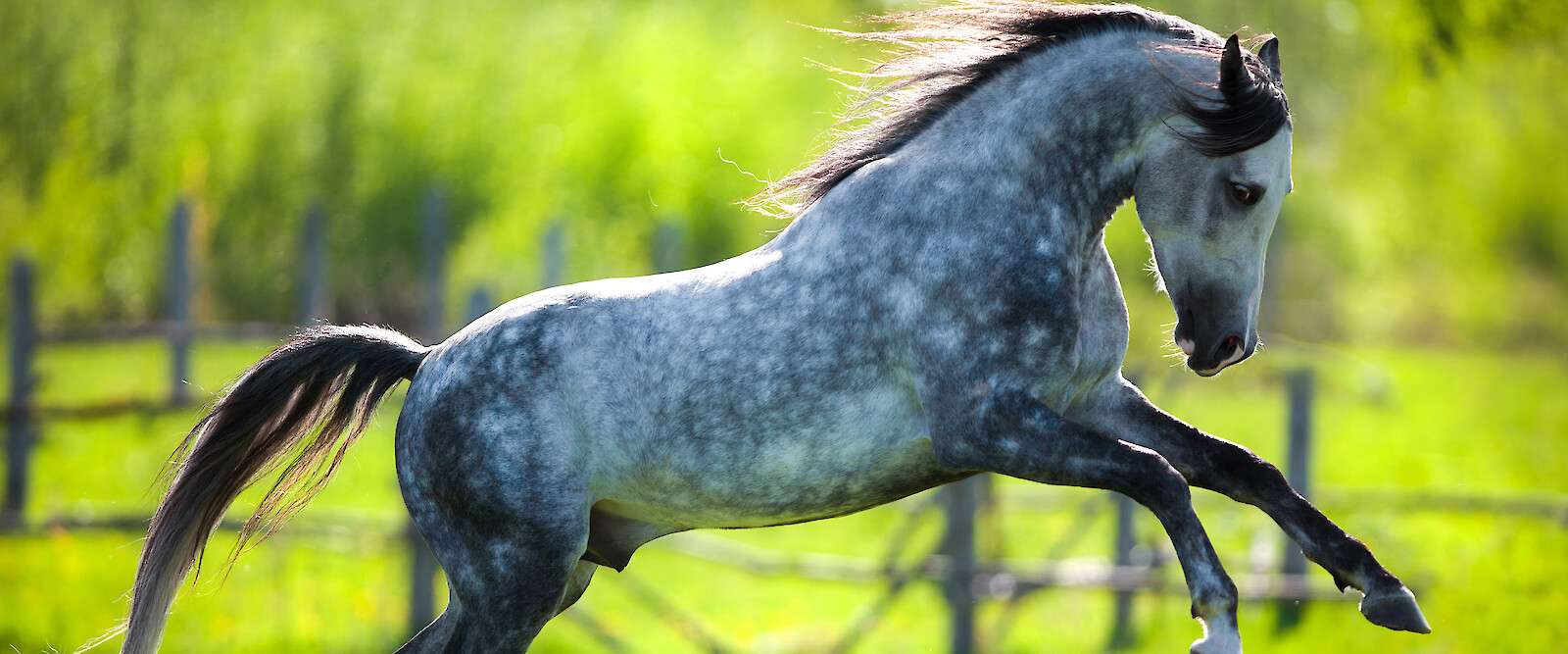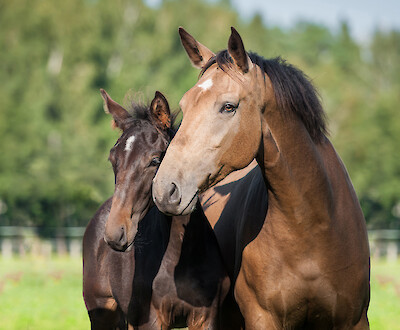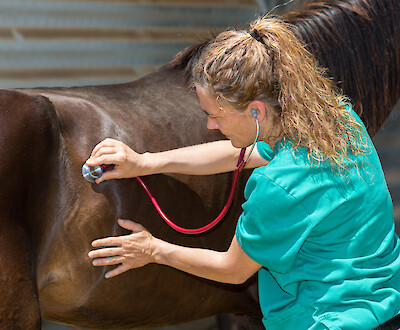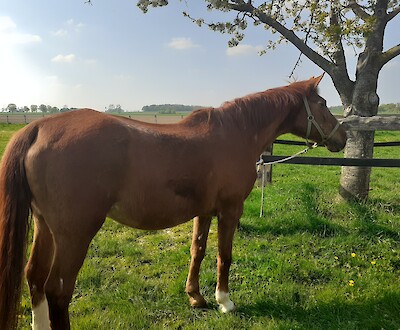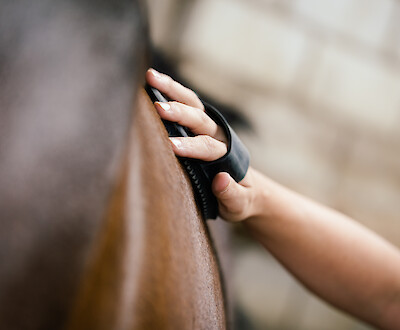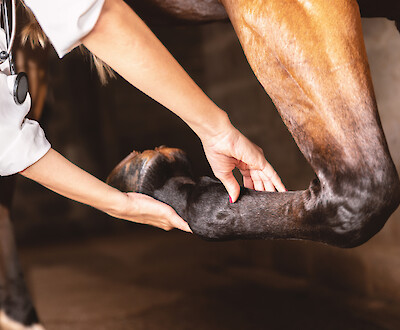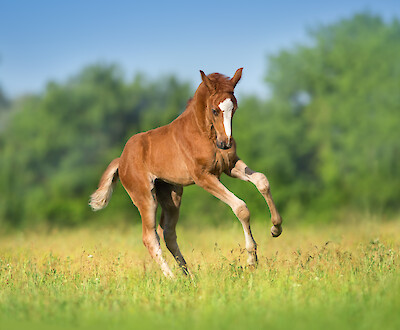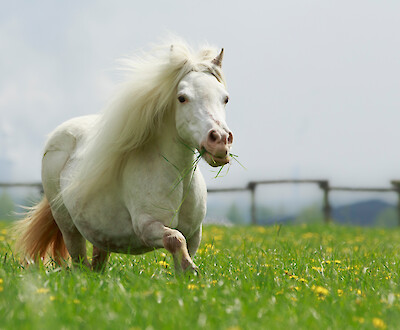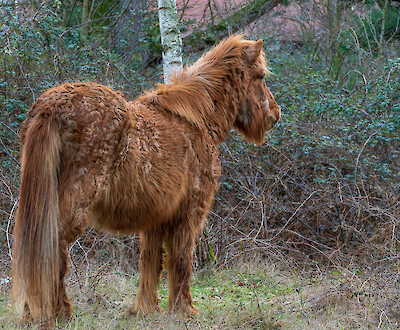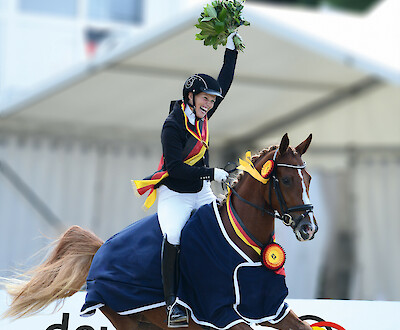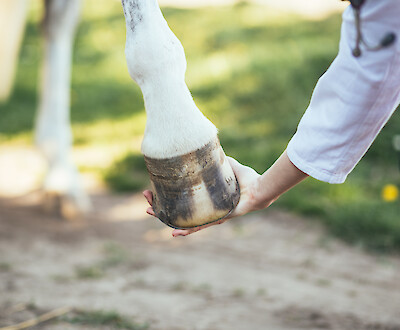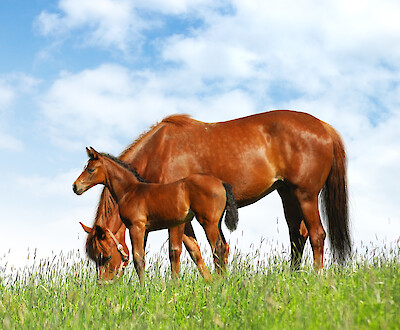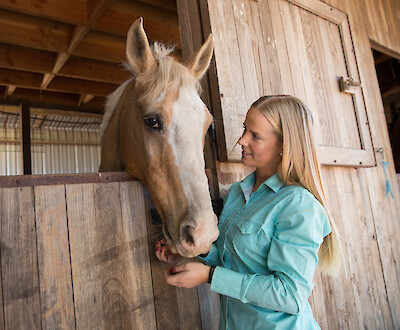Avoiding deficiency symptoms with the help of correct feeding
Selenium and selenium deficiency in horses
Selenium is a vital nutrient that horses need to take in regularly with their food. However, selenium is unevenly distributed in nature. Germany is even considered a selenium deficient area. Hay and grass in this country therefore only contain small amounts of the trace element - often too little to cover the horses' daily needs. Supplementary feeding with appropriate feed can help prevent a deficiency or compensate for an existing undersupply. Nevertheless, caution is advised: Horses can also find it difficult to cope with too high a dose of selenium.
Germany, a Selenium deficient area?
The most important source of sel enium for horses is pasture grass and hay (or haylage). How much selenium the forage plants contain depends on the nutrient content of the soils on which they grow. Germany is considered to be a selenium-poor area overall. However, the selenium content of the soils sometimes varies considerably from region to region. For example, the amount of selenium in southern German soils is significantly lower than in the northern German states. Acidic soils in particular (e.g. moors, sandy areas or in alluvial areas) contain only small amounts of the trace element.
For many areas, therefore, the following applies: You cannot usually cover your horse's daily selenium requirement with pasture grass and hay alone; at least not if the grassland is not enriched with selenium via a special fertiliser. However, this is rarely the case.
Selenium content of your horse's feed: This is how much is in it
|
|
mg/kg dry matter |
|
Pasture grass, moderately fertilised |
0,04 |
|
Hay, meadow, medium quality |
0,1 |
|
Lucerne hay |
0,06 |
|
Maize silage |
0,18 |
|
Fodder beet |
0,03 |
|
Molasses |
0,03 |
|
Dried pulp |
0,05 |
|
Carrots |
0,02 |
|
Oats |
0,08 |
|
Wheat bran |
0,05 - 0,4 |
|
Soya extraction meal |
0,2 - 0,4 |
Selenium and its effect: involved in many important functions in the horse's body
Selenium is a well-known nutrient and of great importance for the care of your horse. The trace element is involved in important metabolic processes. That is why it is also considered an essential, i.e. vital nutrient. It is absorbed in the small intestine and then stored in the skeletal muscles (approx. 40 percent) and liver (approx. 30 percent). - Selenium fulfils two central tasks in your horse's body:
-
Selenium protects the cells
A sufficient intake with the daily feed can help prevent cell damage caused by so-called free radicals. Free radicals are aggressive oxygen compounds that damage cells and their components (e.g. genetic material). They are caused, among other things, by extreme external influences (e.g. heat, strong sunlight), by stress but also by muscle work of your horse. Possible consequences are inflammatory processes in the horse's body and premature ageing of the cells. Selenium is considered an antioxidant, which means that it inactivates free radicals and protects your horse's cells and tissue from their harmful consequences. -
Selenium for optimal energy metabolism
Selenium interacts closely with your horse's hormone system. The supply of the trace element has a direct effect on the function of the thyroid gland. Here, for example, the nutrient is involved in the activation/deactivation or conversion of various thyroid hormones (e.g. thyroxine to triiodothyronine), with which the thyroid gland controls the energy metabolism of the body.
A sufficient supply of selenium therefore has many positive effects on your horse. The cell metabolism is supported and the stability of the body cells is promoted. The trace element ensures good regeneration of the muscles after intensive exertion. Furthermore, it supports liver detoxification and ensures healthy coat and hair growth. A sufficient and adequate supply of selenium counteracts inflammatory processes caused by free radicals. Thus, sufficient selenium can indirectly support your horse's immune system. Finally, the positive effect on the fertility of mare or stallion should also be mentioned here.
Selenium requirements for horses
The specific selenium requirement of a healthy horse depends on various factors. The average requirement is 0.10 to 0.15 mg selenium per kg dry feed mass daily. Thus, a horse weighing 600 kg with a daily intake of about 11.5 kg forage dry matter (corresponding to about 13.0 kg fresh matter in a ration of concentrate and hay) should take in at least 1.15 mg selenium per day. Physical work, growth and lactation are performance areas that increase the daily selenium requirement.
Selenium deficiency in horses: signs and symptoms
A selenium deficiency in horses is usually difficult to recognise at first glance. A minor deficiency is almost invisible to outsiders. Possible symptoms of a selenium deficiency in horses are:
- low performance, sluggishness
- Degradation of the musculature
- Tendency to infections
- brittle coat and hair loss
- reduced fertility
A particularly severe undersupply sometimes manifests itself in hair breakage, (colicky) muscle cramps, cross-contagion and/or stiffness of the hindquarters (syn. ataxia).
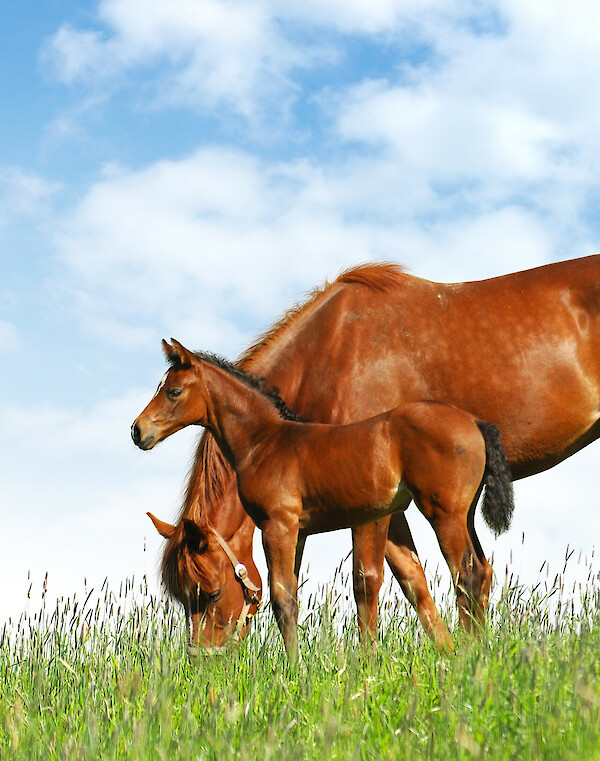
Consequences of selenium deficiency in foals: White muscle disease
Selenium deficiency is particularly noticeable in foals: they sometimes develop degenerative muscle changes, also known as white muscle disease or nutritive muscular dystrophy (NMD ).
The disease manifests itself in a stiff gait, buckling of the limbs and other lameness. Also, the foal often cannot turn its head properly when suckling because the neck muscles are impaired. Another sign is brownish coloured urine.
White muscle disease usually develops as a result of selenium deficiency in the pregnant mare, which has a direct effect on the selenium supply of the foal. You should therefore pay special attention to the selenium supply of pregnant and lactating mares.
Diagnosis of a selenium deficiency in horses: is a blood count enough?
A selenium deficiency is diagnosed by the veterinarian. A common method for determining the selenium concentration is a blood test. Until now, if the measured selenium value is below the reference range of 100 - 200 µg/l, one speaks of a selenium deficiency. However, the significance of the blood test as the sole diagnostic procedure is currently being disputed in research.
in 2018, a study of 528 horses by researchers from Leipzig showed that about half of the animals examined had an insufficient selenium supply. However, all of the horses were in good health. Symptoms indicating a lack of selenium were not recognisable. This triggered a debate about whether the reference values should not be lowered to 70 - 170 µg/l. Already, some laboratories have adjusted the lower limit to 70 µg/l. The results also gave reason to see blood more as a transport medium for nutrients and to give greater weight to the influence of external factors (e.g. stress, physical strain, abstinence from food or illness) on the occurrence of a deficiency symptom.
For diagnostics in practice, the following procedure for assessing selenium supply is recommended against the background of current findings:
- Analysis of blood values,
- Carrying out a ration analysis of the feedstuffs used, and
- additional assessment of the general condition of your horse.
If a selenium supply appears to be assured "on paper" and if both a good condition and no symptoms of a deficiency appear, then an additional selenium supplementation is not necessarily necessary, even if it falls below the reference range. After a few weeks, a second blood count should be taken.
Tracking down selenium deficiency: Analysis of your horse's own feed ration
In order to determine the appropriate amount of selenium-containing feed, you should first analyse the basic feed (roughage) in your ration. This will tell you the specific nutrient content and thus the selenium content of the basic feed. The selenium content of your concentrated feed can be found in the declaration on the bags.
You can request a corresponding analysis from various laboratories. In order to create a test order, use for example the here linked request form. Simply select the provider, choose "hay / haylage", fill in the form, send it off, done!
If the analysis of the feed ration shows that your horse's selenium supply is not ensured by the feed, you should consider supplementing it with a selenium-containing feed. Mineralised supplementary feeds or supplements or high-quality mineral feeds (e.g deukavallo Mineral).
If your horse suffers from a specific selenium deficiency, it makes sense to feed a higher-dose selenium preparation (e.g deukavallo Vitamin E + Selenium) for a short period of time. But also in times of increased selenium requirements during intensive sporting phases or in the case of existing metabolic disorders (e.g. polysaccharide storage myopathies, PSSM), feeding a selenium preparation can make sense.
As selenium interacts with other minerals and nutrients (e.g. vitamin E), you should always check the levels of the other nutrients as well. In order to improve selenium intake, it can therefore be useful to feed vitamin E or zinc in addition. Studies have shown that both nutrients improve selenium uptake in the long term. Vitamin C, on the other hand, can reduce selenium uptake.
Interaction and interaction of selenium and vitamin E
The nutrients selenium and vitamin E are closely related. Both substances act as antioxidants and bind or inactivate free radicals. A vitamin E deficiency - like a selenium deficiency - can cause muscle degeneration and movement disorders as well as promote a selenium deficiency. In contrast, a sufficient supply of vitamin E also improves the horse's selenium absorption.
The specific need for vitamin E depends strongly on the performance of your horse. Sport horses, brood mares and foals have a higher vitamin E requirement than adult horses standing on pasture. To counteract or prevent a selenium deficiency, you should therefore always ensure a sufficient supply of Vitamin E selenium.

Calculation of the ration: Adjusting the feed to your horse's selenium requirements
In order to keep an eye on the interaction of the various nutrients and the total amount of selenium in the feed ration, professional advice is recommended. The feed experts at deuka companion will help you plan your feed. Our product management will be happy to carry out a ration calculation for you. The concrete ration planning helps you to optimally cover your horse's nutritional requirements.
You want to have a ration calculation carried out? Then send an e-mail containing information about your horse (e.g. age, exercise, diseases, etc.) and the results of the feed analysis (see above) to the following address: deukavallo@deutsche-tiernahrung.de
Selenium overdose: The amount makes the poison
An adequate supply of selenium makes an important contribution to the health of your horse. An undersupply, on the other hand, has negative effects on the performance and well-being of your horse in the long run. But an oversupply of selenium can also have a negative effect on your horse. The following applies: The amount makes the poison.
If horses receive too much selenium in their daily feed over a long period of time, chronic selenium poisoning can develop. This usually manifests itself in hair loss in mane and tail. But also unspecific lameness, heavy sweating, colic or, in the worst case, "shoeing out" (i.e. detaching of the hoof) are signs that point to a selenium overdose. If nothing is done, the horse may even die.
It is not clearly defined when selenium leads to poisoning. Studies currently suggest a total amount of 2.0 mg of selenium per kilogram of dry matter as the maximum daily intake.
Conclusion: Selenium and selenium deficiency in horses
-
Selenium plays an important role in the metabolism of the horse's body. It binds free radicals and functions as an important antioxidant.
-
The trace element is primarily absorbed through basic and roughage.
-
The selenium content in forage plants is generally very low in Germany. Therefore, it is seldom possible to supply the required amount of selenium via the basic fodder.
-
Selenium deficiency can manifest itself in reduced performance and muscle tension. A weakened immune system or ageing processes are also possible symptoms of a selenium deficiency.
-
To cover the horse's selenium requirements, you should feed a selenium-rich horse feed as a supplement. These are available as mineralised supplementary feeds or in high doses as additional feeds or supplements (e.g deukavallo vitamin E + selenium) or high-quality mineral feeds (e.g deukavallo Mineral) are available.
Questions and answers
-
The selenium requirement of a horse depends on various factors. Basically, a horse weighing about 600 kg has a daily selenium requirement of about 1.2 milligrams. However, the selenium content of a daily ration should always be in the right proportion to the other nutrients and active substances, as these can strongly influence each other in their utilisation.
-
Selenium deficiency is mainly manifested in a severe drop in performance and exhaustion of the horse. An increased tendency to infections and allergies can also be observed with a selenium deficiency. In the case of a pronounced selenium deficiency, the gait becomes increasingly stiff and symptoms similar to cruciate rash can occur.
-
If a horse has a proven selenium deficiency, it makes sense to offer the horse's body a supplement (e.g. deukavallo vitamin E + selenium) in addition to the regular horse feed. In this way, deficiencies can be avoided.
-
Selenium takes on various tasks in the horse's body. It mainly acts as an antioxidant and protects body cells from harmful free radicals. It strengthens the immune system, is involved in various metabolic processes and takes on important tasks in hormone balance (e.g. in the thyroid gland). Selenium also influences fertility.
Image sources: © Alexia Khruscheva - stock.adobe.com / © Kseniya Abramova - stock.adobe.com / © antje.rotpunkt - stock.adobe.com
Contact person

Barbara Wefers
Contact person



